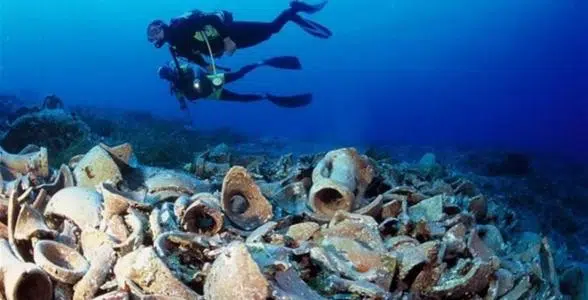
The 4,200-year-old shipwreck off the tiny island of Dokos near Greece’s Hydra is believed to be the oldest shipwreck ever discovered.
The wreck, located about 15 to 30 meters (50–100 ft) underwater, is dated to the Early Helladic period (2700-2200 BC) and consists mainly of a large collection of ceramic items that were likely cargo on the ship. The wooden parts of the ship have long since decomposed.
The Dokos shipwreck was discovered in 1975 by the American underwater archaeologist Peter Throckmorton. Since then, successive dives at the site have identified more than 500 well-preserved kitchen vessels, urns, cups, and seven or eight kinds of sauceboats.
Although archeologists have found obsidian stones from the Greek island of Milos, dated around 7000 B.C., in caves on the Peloponnese mainland, “Dokos is especially interesting because it’s the first actual proof we have of nautical trade from this period,” said George Papathanasopoulos, head of the 20-member team that completed excavation of the artifacts.
Dokos shipwreck includes anchors and hundreds of ceramics
Their findings include stone anchors and hundreds of ceramics dating from around 2250 B.C. in the early Helladic period, a Bronze Age period about which little is known. The Dokos site is a boon to archeologists not only because it is ancient but also because it is untouched by succeeding civilizations.
Papathanasopoulos suggested the ship probably belonged to a rich merchant. She came from the Greek mainland somewhere northeast of Athens, and her cargo included many ceramics from the Cyclades islands several hundred miles east of Dokos. The ship probably sank after running aground as she tried to enter the harbor.
The bowls and sauceboats of the Early Helladic period were the most common types found in Southern and Central Greece.
After further inspection of the sauceboats, it has been suggested that these types resemble those from Askitario in Attica and are also comparable to ones from Lerna and the Cyclades.
What was the trade route of the ship?
Evidence shows the shipwreck may lie on the maritime trade route from South Euboea to the Saronic and Argolid Gulfs. There were many amphorae found, as well as basins, wide-mouthed jars, braziers, baking trays, askoi, pithoi, and common household utensils.
Dr. Fredrick van Doorninck, a professor of anthropology at the institute, said the artifacts at Dokos had been positively identified as ones from the early Helladic period, but he said they might have fallen from the ship rather than sunk with it. Alternatively, they might have been thrown overboard as votive offerings. “No convincing argument on this has yet to be presented,” he said.
However, most marine archaeologists say evidence points to a shipwreck. First, the bay is a natural harbor on a known trade route. While overseeing the underwater research, Papathanasopoulos found what he said was evidence of two early Helladic period settlements on Dokos.
Then, there are the artifacts themselves. The large number of similar ceramics suggests a ship’s cargo, researchers say. They have also uncovered numerous millstones, often used by ships as ballast. Archeologists have also recovered two lead ingots that Papathanasopoulos believes come from the mines of Lavrion, about 40 miles south of Athens.
A short distance from the site, they found two boulders with holes bored through the top, possibly the oldest stone anchors ever found. This is the first time stone anchors have been found in conjunction with a possible ancient shipwreck, the researchers said, and they should enable scientists to date the find more accurately.
If the Dokos ship was like those depicted on vases from that period, it was probably at least 80 feet long, propelled by oars, with a low prow and a high stern, said Yiannis Vichos, a marine archeologists and specialist on ancient ships who was on the team.
See all the latest news from Greece and the world at Greekreporter.com. Contact our newsroom to report an update or send your story, photos and videos. Follow GR on Google News and subscribe here to our daily email!



